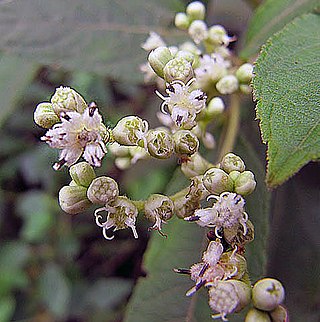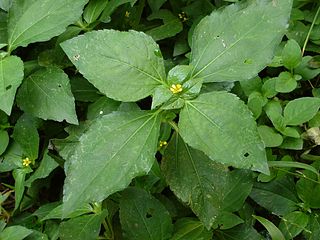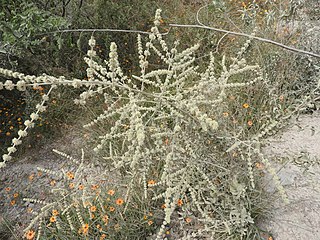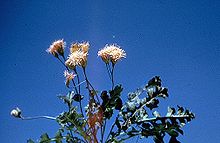
Grindelia (gumweed) is a genus of plants native to the Americas belonging to the family Asteraceae. The genus was named for Latvian botanist David Hieronymus Grindel, 1776–1836.

Sanvitalia ), the creeping zinnias, is a genus of flowering plants belonging to the family Asteraceae. They are native to mostly to Mexico, with a few species in Central America, South America, and the Southwestern United States.
Chamguava is a genus of the botanical family Myrtaceae, first described as a genus in 1991. It is native to southern Mexico and Central America.
- Chamguava gentlei(Lundell) Landrum - Chiapas, Belize, Guatemala, Honduras
- Chamguava musarum(Standl. & Steyerm.) Landrum - Guatemala
- Chamguava schippii(Standl.) Landrum - Guerrero, Chiapas, Belize, Guatemala, Panama

Clibadium is a genus of flowering plants in the family Asteraceae.

Pseudogynoxys is a genus of flowering plant in the groundsel tribe within the sunflower family, native to North and South America.

Pittocaulon is a genus of Mexican shrubs and small trees in the tribe Senecioneae within the family Asteraceae.
Critoniadelphus is a genus of flowering plants in the family Asteraceae.

Peteravenia is a genus of Mesoamerican plants in the tribe Eupatorieae within the family Asteraceae.
Espejoa is a genus of Mesoamerican flowering plants in the daisy family.

Gymnosperma is a genus of North American flowering plants in the family Asteraceae.
Wamalchitamia is a genus of Mesoamerican flowering plants in the family Asteraceae.
Lundellianthus is a genus of Mesoamerican flowering plants in the tribe Heliantheae within the family Asteraceae.

Synedrella is a genus of flowering plants in the family Asteraceae.

Crusea is a genus of angiosperms in the family Rubiaceae. The genus is found in the south-western United States, Mexico, and Central America. A few species are naturalized in Cuba and Puerto Rico.
Trixis inula, the tropical threefold, is a plant species native to Texas, Mexico, Central America, northern South America, and the West Indies. It is found on open, sandy sites such as roadsides, thorn scrub, thickets, etc.
Chaptalia albicans, the white sunbonnet, is a plant species native to Mexico, Central America and the West Indies. It is known from Jamaica, Cuba, Guatemala, Belize, Honduras, southern Florida, the Bahamas, Hispaniola, Puerto Rico, San Luis Potosí, Veracruz, Yucatán, Campeche and Chiapas.

Asterohyptis is a genus of plants in the Lamiaceae, or mint family, first described in 1932. It is native to Mexico and Central America.
- Asterohyptis mocinoana(Benth.) Epling - widespread from Veracruz to Costa Rica
- Asterohyptis nayaranaB.L.Turner - Durango, Nayarit
- Asterohyptis seemannii(A.Gray) Epling - Chihuahua, Sonora, Sinaloa
- Asterohyptis stellulata(Benth.) Epling - from Sinaloa and Durango south to Honduras

Cunila is a genus of plants in the Lamiaceae, first described in 1759. It is native to North and South America.
- Cunila angustifoliaBenth. - southern Brazil, Misiones Province of Argentina
- Cunila crenataGarcía-Peña & Tenorio - State of Durango in Mexico
- Cunila fasciculataBenth. - southern Brazil
- Cunila galioidesBenth. - Brazil
- Cunila incanaBenth. - southern Brazil, Argentina
- Cunila incisaBenth. - southern Brazil
- Cunila leucanthaKunth ex Schltdl. & Cham. - Mexico, Central America
- Cunila lythrifoliaBenth. - central + southern Mexico
- Cunila menthiformisEpling - southern Brazil
- Cunila menthoidesBenth. - Uruguay
- Cunila microcephalaBenth. - southern Brazil, Argentina, Uruguay
- Cunila origanoides(L.) Britton - central + eastern United States from Texas and Kansas east to New York and Georgia
- Cunila platyphyllaEpling - southern Brazil
- Cunila polyanthaBenth. - Mexico, Central America
- Cunila pycnanthaB.L.Rob. & Greenm. - Mexico
- Cunila ramamoorthianaM.R.Garcia-Pena - Mexico (Guerrero)
- Cunila spicataBenth. - southern Brazil, Argentina, Uruguay, Paraguay
- Cunila tenuifoliaEpling - southern Brazil

Arctotis venusta is a species of South African plants in the family Asteraceae. Common names include silver arctotis, kusgousblom, and blue-eyed African daisy. It is native to the western coast of South Africa, The species is widely cultivated as an ornamental, and has become naturalized in parts of the United States, Australia, and Central and South America, where it has escaped from gardens to become a noxious weed.

Cirsium horridulum, called bristly thistle, purple thistle", or "yellow thistle is a North American species of plants in the tribe Cardueae within the family Asteraceae. It is an annual or biennial. The species is native to the eastern and southern United States from New England to Florida, Texas, and Oklahoma as well as to Mexico, Belize, Guatemala, Honduras, and the Bahamas.













